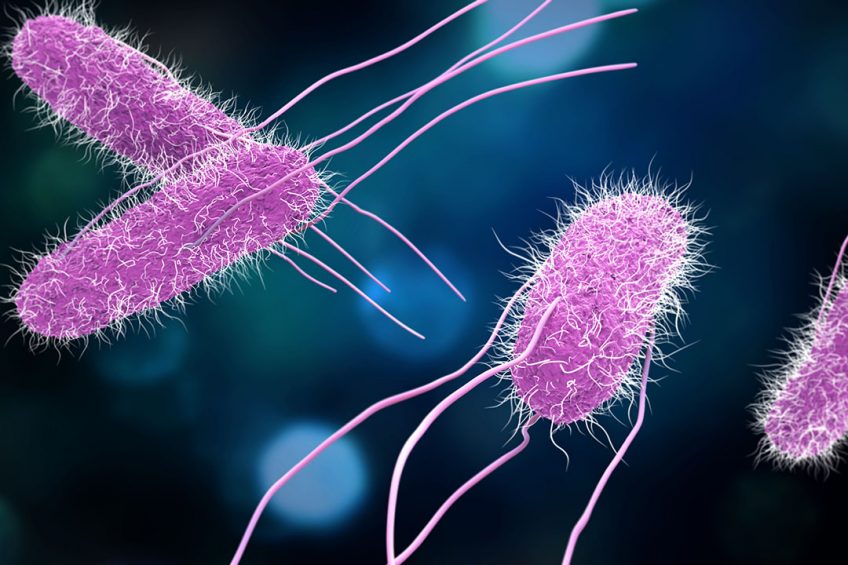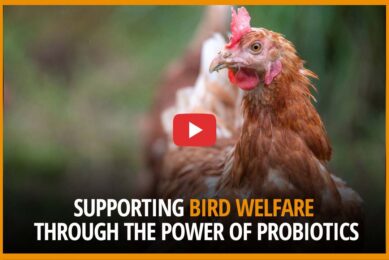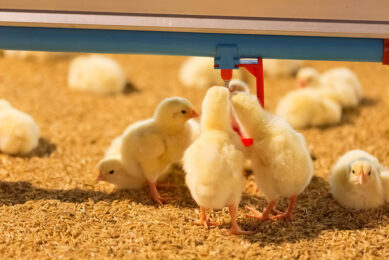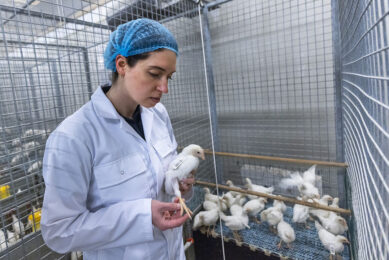Preventing pathogens using Bacillus-based probiotics

Keeping poultry healthy is key in modern farm management. Prevention is much more effective and cost-efficient than having to treat disease. Probiotics are as one of the strategies being used to insure health.
Proven, effective probiotics are a sustainable, natural solution, and play an integral part of prevention programmes on the farm. Bacillus-based probiotics are particularly well-suited for use in broiler feeds. Their spores are metabolically dormant and resilient to environmental stresses, including pelleting. With Bacillus-based probiotics, the main mechanisms of action for disease prevention, as well as keeping bird-health balance, are biofilm creation at the top of the villi at enterocytes level, competitive exclusion, bacteriocin production and immune system modulation.
Recent Chr. Hansen scientific studies helped improve overall understanding and demonstration of the complementary modes of action of Bacillus based probiotics in preventing Salmonella contamination risks:
 Bacillus subtilis creates a protective biofilm on the enterocytes – a natural barrier for the pathogens.
Bacillus subtilis creates a protective biofilm on the enterocytes – a natural barrier for the pathogens.
The ability of Bacillus spores to germinate and become viable organisms in the intestine was clarified in 2008 by Cartman et al. The research showed that orally administered Bacillus subtilis spores germinate in the chicken’s gastrointestinal tract (GIT). Continuous administration of an effective Bacillus subtilis probiotic is advisable to achieve persistent benefits.
Bacillus subtilis are transient…
Bacillus subtilis colonise in the intestinal epithelium. (Figure 1). Konieczka P., et al. (2018 ), with the support of Chr. Hansen Innovation laboratory, performed a fluorescence in situ hybridisation (FISH) trial to investigate spatial organisation and formation of Bacillus subtilis biofilms. Intestinal samples from various GIT locations in 6 broiler chickens were used. In Figure 1, the white fluorescence on top of the villi can be seen, as well as some luminescence inside the lumen of the intestine. This shows that transient Bacillus are in the intestine, live and multiplying into the lumen of the gut content.
Figure 1 – Bacillus subtilis on the villi surface and in the digesta.

… and are at the right place to act
Figure 1 illustrates that Bacillus from Chr. Hansen are able to colonise at the top of the villi. This site is one of the most sensitive parts of the epithelium. Many nutrients are absorbed here thanks to the full development of the microvilli. Most of the pathogens are acting to destroy the mucosae (C. perfringens, E. coli, Salmonella). By coating the epithelium at this place, Bacillus can bring the following advantages:
The right place to make bacteriocins efficient
Some Bacilli are specifically strong in production of bacteriocins against unfavourable bacteria. Bacillus subtillis strains from Chr. Hansen have the ability to produce peptide bacteriocin substances like bacillibactin, fengycin, iturin, mycosubtilin and surfactin that inhibit both gram negative and gram positive pathogens.
The right place for competitive exclusion
For their own development, Bacilli are able to produce multiple active enzymes in the intestinal tract. Once these enzymes are released, they continue to act on insoluble or indigestible fractions of feed cutting it into smaller pieces which are then readily absorbable by enterocytes. Feed efficiency is improved and feed residue reduction in the intestine means less available nutrient sources for most pathogenic bacteria (Clostridium sp., E. coli or Salmonella sp.).
 Bacillus subtilis performs as an immune modulator
Bacillus subtilis performs as an immune modulator
The gastrointestinal tract is both an immune barrier as well as a huge absorptive surface. Probiotics modify the physical shape and structure of the intestine (villi length, crypts’ depth) and can influence the Goblet cells numbers. 70% of the chicken’s total immune system is located in the GIT. In a recent C. perfringens challenge trial, pro-inflammatory cytokines gene expression was measured in a group of broilers fed with or without probiotic supplementation (GalliPro Fit). A comparison between challenge and not challenged birds was done.
The probiotic primes the immune response
The group receiving a new 3 strain Bacillus-based probiotic (GalliPro Fit) without NE challenge showed no up-regulation of the pro-inflammatory cytokines genes. In the presence of the NE challenge, the group receiving the probiotic showed significant expression of the intercellular cytokines (Figure 2). Summarising, if needed, the immune system reacts faster and more efficiently in birds fed with GalliPro Fit.
Figure 2 – Cytokine Expression based on Mean Fold Change (PCR).

 The probiotic can reduce intestinal colonisation of S. enteritidis
The probiotic can reduce intestinal colonisation of S. enteritidis
Salmonella: Typhimurium, Enteritidis and Heidelberg are 3 of the most prevalent serovars implicated in foodborne diseases. 2 entry points are possible, either Salmonella penetration through a direct eggshell contamination during lay or a direct albumen or yolk contamination from an infected ovary. Recently, in a S. enteritidis challenge trial with the multi-strain probiotic, a 14% pathogen reduction in birds colonised with Salmonella (2 weeks post infection) was observed in the probiotic supplemented group. The probiotic has shown properties of inhibition of Salmonella growth in laboratory experiments, and now confirmed in live production conditions. Less Salmonella colonisation in the intestinal tract means less contamination risks of the faecal contents, which lead to decreased likelihood of Salmonella contamination in produced eggs.
Scratching the ‘probiotic potential’ surface
Incorporating a new 3-strain Bacillus-based probiotic into a pathogen prevention programme can protect the top of the villi and thus prolong and protect intestinal absorptive surface, compete for space and nutrients, thereby excluding pathogens from GIT, as well as free bacteriocins that inhibit intestinal pathogens. Furthermore, it can release enzymes locally, to digest indigestible feed fraction and reduce nutrients for pathogenic bacteria. It can also perform as an
immune modulator and reduce the intestinal colonisation of Salmonella in the intestinal tract, which helps to reduce risks of meat and egg contamination. Over years of controversial debate, the answer from science-based evidence shows that we are just scratching the probiotic potential surface in poultry production. These recently discovered modes of action confirm the bright future for this technology to be a part of pathogen prevention programmes.
Author: Jean-Christophe Bodin, Sr Product Manager, Chr. Hansen Animal Health
Join 31,000+ subscribers
Subscribe to our newsletter to stay updated about all the need-to-know content in the poultry sector, three times a week. Beheer
Beheer





 WP Admin
WP Admin  Bewerk bericht
Bewerk bericht